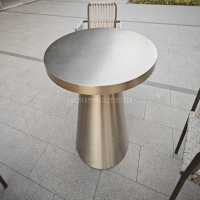Welcome to the website for landscape facilities products and knowledge.
How does the table’s design accommodate the use of tactile or braille signage?
Modern table design has evolved significantly to accommodate tactile and Braille signage, creating inclusive environments for visually impaired individuals. Designers incorporate these accessibility features through several innovative approaches that maintain both functionality and aesthetic appeal.
The most common method involves embedding Braille plates directly into table edges or surfaces. These plates are typically made from durable materials like stainless steel, brass, or high-quality plastic, ensuring longevity despite frequent tactile use. The Braille characters are raised sufficiently to be easily readable through touch, while maintaining a smooth enough profile to prevent snagging clothing or causing discomfort.
Another approach integrates tactile signage into table legs or supporting structures. This placement allows users to locate identification markers without interfering with the table's primary surface area. Designers often position these markers at consistent heights, typically between 48-54 inches from the floor, following ADA guidelines to ensure easy reachability for both seated and standing users.
Table designers also consider contrast and color differentiation when incorporating accessibility features. High-contrast coloring between Braille markers and the table surface helps individuals with partial vision identify signage locations more easily. Some designs incorporate tactile maps or directional indicators that guide users to specific seating areas or service locations.
Innovative solutions include tables with interchangeable signage panels, allowing venues to modify identification as needed. Magnetic or clip-on systems enable easy updates without replacing entire table components. Other designs feature integrated LED lighting around Braille markings, enhancing visibility for users with limited vision while creating an aesthetically pleasing ambient effect.
Material selection plays a crucial role in successful integration. Designers choose surfaces that complement the tactile elements without compromising readability. Smooth, non-porous materials around Braille markings prevent dirt accumulation and maintain character clarity over time. The underlying table structure often includes reinforced areas to support the additional weight and frequent contact with signage components.
Modern manufacturing techniques like 3D printing have revolutionized how designers create custom tactile elements. This technology allows for precise Braille character formation and innovative placement options previously impossible with traditional manufacturing methods. Some designers even incorporate tactile elements artistically, transforming functional requirements into design features that enhance the overall aesthetic.
The placement strategy considers both accessibility and practical usage. Designers avoid locations where signage might interfere with dining activities or become damaged through regular use. Common positions include table ends, corner markers, or dedicated signage areas separated from primary activity zones. This thoughtful positioning ensures that accessibility features serve their purpose without compromising the table's primary function.
Temperature and environmental factors also influence design decisions. Outdoor tables require weather-resistant Braille markings that withstand temperature variations and moisture exposure. Designers select materials that expand and contract similarly to prevent cracking or character deformation over time. Indoor applications might focus more on aesthetic integration while maintaining tactile clarity.
Ultimately, successful table design for tactile and Braille signage balances multiple considerations: ADA compliance, user experience, durability, and visual harmony. The best designs integrate these elements so seamlessly that they enhance accessibility without appearing as afterthoughts. This approach creates truly inclusive spaces where accessibility features become natural components of the overall design language, benefiting all users regardless of visual ability.
Related search:

Recommendation
Outdoor Metal Table - Classic Outdoor Furniture, Stainless Steel Table, Durable and Reliable